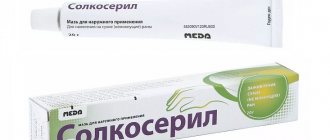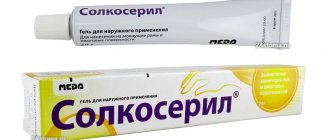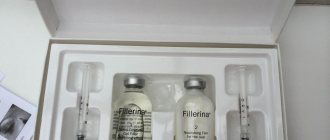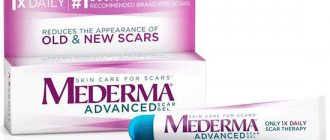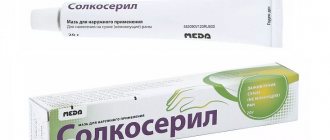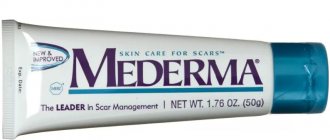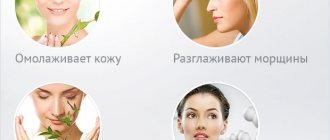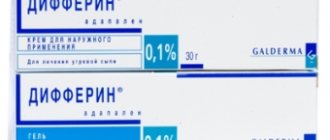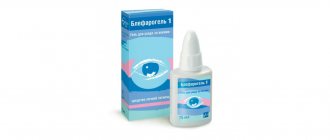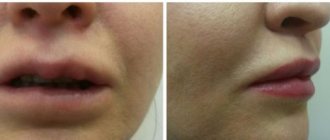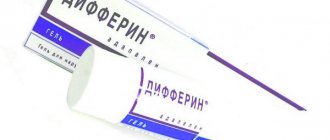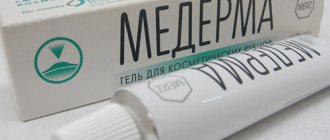What is Solcoseryl ointment used for?
The drug is based on deproteinized dialysate obtained through special processing from the blood of calves. This substance is often used in medicine in countries such as China, Korea, and the entire CIS. It has proven itself to be an effective remedy that can:
- enrich tissue cells damaged due to hypoxia with oxygen and glucose;
- start tissue repair processes;
- activate healthy cell division processes;
- increases the level of energy produced by cells;
- protects the skin from external damage by forming a film on its surface;
- triggers the production of collagen by tissues.
Based on the activity of the drug, the drug can be used for:
- frostbite;
- psoriasis;
- anal ring cracks;
- cuts;
- abrasions;
- scratches;
- bedsores;
- acne marks;
- dermatitis;
First of all, to achieve the best effect, it is necessary to start therapy in the early stages of the problem.
How to use it correctly
To achieve maximum effect, you must carefully follow the instructions. As mentioned above, for the treatment of oral diseases it is best to use dental adhesive paste:
- You must first treat the gums with Miramistin or Chlogexidine.
- Using a bandage, lightly dry the mucous membrane.
- Squeeze a small amount of Solcoseryl (the size of a pea) onto your finger.
- Apply the paste to the desired area using rubbing movements.
- Try not to eat or drink for an hour.
- Repeat the procedure 3-4 times a day.
The drug has a powerful wound-healing effect; you can see the first results literally within a day.
Solcoseryl ointment as a face mask
Cosmetologists claim that the use of Solcoseryl in the early stages of age-related changes allows you to maintain youthful skin. Timely start of use can replace expensive laser rejuvenation in the salon. First of all, Solcoseryl allows you to get rid of wrinkles and prevent their earlier appearance. The ointment is capable of:
- provide adequate nutrition to the facial skin;
- get rid of acne;
- relieve inflammation;
- improve complexion;
- tighten the oval;
- get rid of wrinkles.
The expected effects are possible due to the fact that using a mask allows you to saturate tissues and cells with oxygen and accelerate regeneration. Thanks to the application of the cream, collagen, which is responsible for skin elasticity, begins to be actively produced. The more collagen produced, the fewer wrinkles your skin will have. It is like a support for a heavy skin sheet, preventing its individual areas from falling through, preventing the formation of wrinkles.
Gel Solcoseryl: reviews
An important condition for achieving a good treatment result is the correct choice of the form of the drug Solcoseryl - this can be in the form of a gel, ointment or dental adhesive paste.
The effect of the gel will be noticeable specifically on wet wounds, and consists in accelerating the formation of granulation tissue by about 30%. You will not notice the effect of the gel when used on dry wounds, and it is unlikely that you will be able to leave a good review of the product after this. Solcoseryl gel will have a good pronounced effect and will accelerate the healing of wounds and ulcer erosions, unless, of course, they are related to tumor-like lesions. The latter must be especially borne in mind, because if the erosion or ulcer has existed for a long time, or there is no effect when using Solcoseryl, then these are signals indicating that this lesion of the mucous membrane/skin is related to tumor-like tissue damage.
Another important point is applying the drug to infected wounds. For the drug to give a good result, there must be no infection in the wound. Purulent wounds, as well as wounds with torn edges, first require primary surgical treatment and drug therapy. Reviews for Solcoseryl gel will be positive only if you carefully follow all recommendations for its use. Failure to follow the recommendations for use, especially with regard to infected wounds, can, on the contrary, lead to increased inflammation.
Solcoseryl anti-wrinkle gel in cosmetology: reviews
Some patients persistently try to use Solcoseryl gel for the face to get rid of wrinkles. The logic here is clear - since the drug increases proliferation (reproduction) and activity of fibroblasts, then its use should seem to lead to an increase in collagen production. Unfortunately for patients, it must be noted that none of the forms of solcoseryl work on intact skin.
Therefore, Solcoseryl ointment or gel is not used in cosmetology, and they are effective only for accelerating the healing of skin damage, including after surgical and cosmetic interventions. To stimulate collagen production in aging skin, it is better to use retinoid-based products, and an even faster effect is achieved by a hardware technique that uses fractional lasers. These techniques do have proven evidence of increasing collagen in the skin (see links above for arguments and clinical studies).
If you are interested in a cream that can improve skin regeneration and keep it moisturized, especially in winter, one of the best options would be to use Bepanthen for Dry Skin cream. It contains not only dexpanthenol (a precursor to vitamin B5, which enhances skin regeneration), but also moisturizing components such as the emollient “lanolin”, as well as D, L-pantolactone. I recommend this product because... I myself use it 2 times a day in the winter and see its effectiveness from personal experience. It can even be applied to the moving parts of the eyelids. A 100 ml tube costs only about 950 rubles.
Solcoseryl injections: what for
Any surgical intervention is accompanied by a violation of the integrity of the skin and tissues. If the operation involves the removal of some fragment of an internal organ, the body will require a long rehabilitation period, during which the body will be fully or partially restored. Solcoseryl in ampoules can be instantly delivered to tissues, shortening the recovery period. Injections allow you to mobilize all the internal forces of the body to heal wounds, cuts and sutures not only on the outside, but on the internal organs that remain after operations.
Special cases include the prescription of intravenous or intramuscular administration to patients after ophthalmological operations. Solcoseryl ensures active blood circulation, which accelerates the process of adaptation of the organ of vision in the postoperative period, and also reduces the risk of complications.
Solcoseryl (gel), gel for external use, 20 g, 1 pc.
Solcoseryl injection solution:
IV
or
IM
.
In the treatment of occlusive diseases of peripheral arteries in stages III–IV according to Fontaine
- IV 20 ml daily. Intravenous drip administration in isotonic sodium chloride solution or 5% glucose solution is possible. The duration of therapy is up to 4 weeks and is determined by the clinical picture of the disease.
In the treatment of chronic venous insufficiency accompanied by trophic disorders (Ulcera cruris)
- IV 10 ml 3 times a week. The duration of therapy is no more than 4 weeks and is determined by the clinical picture of the disease. An important additional measure aimed at preventing peripheral “venous” edema is the application of a pressure bandage using an elastic bandage.
In the presence of local trophic tissue disorders, simultaneous therapy with Solcoseryl jelly and then Solcoseryl ointment is recommended.
In the treatment of ischemic and hemorrhagic strokes in severe and extremely severe forms
as the main course - 10 or 20 ml intravenously, respectively, daily for 10 days. Upon completion of the main course - 2 ml intramuscularly or intravenously for 30 days.
Traumatic brain injury (severe brain contusion)
- IV 1000 mg, daily for 5 days.
If intravenous administration of the drug is not possible, the drug can be administered intramuscularly, usually 2 ml per day undiluted.
When using the undiluted drug intravenously, it must be administered slowly, since it is a hypertonic solution.
Solcoseryl gel, ointment:
topically.
Apply directly to the wound surface after preliminary cleansing of the wound using a disinfectant solution.
Before starting treatment of trophic ulcers, as well as in cases of purulent infection of the wound, preliminary surgical treatment is necessary.
Solcoseryl gel is applied to fresh wounds, wounds with wet discharge, and to ulcers with signs of weeping - a thin layer on a cleaned wound 2-3 times a day. It is recommended to lubricate areas where epithelization has begun with Solcoseryl ointment. The use of Solcoseryl gel continues until pronounced granulation tissue forms on the damaged skin surface and the wound dries out.
Solcoseryl ointment is used primarily for the treatment of dry (non-wetting) wounds.
Solcoseryl ointment is applied in a thin layer to a cleaned wound 1-2 times a day; it can be used under bandages. The course of treatment with Solcoseryl ointment continues until the wound is completely healed, its epithelization and the formation of elastic scar tissue.
For the treatment of severe trophic damage to the skin and soft tissues, the simultaneous use of parenteral forms of Solcoseryl is recommended.
How to inject Solcoseryl for gastritis
Gastritis is a disease of the gastric mucosa that can occur for various reasons. Solcoseryl ampoules will not become the main drug used in the treatment of gastritis, but it can speed up the healing process, while the prescribed therapy will relieve the patient of the source of the problem.
The gastric mucosa can become inflamed not only as a result of poor nutrition, but also as a result of infection with gastrointestinal infections. The attending physician will first conduct an examination and evaluate the test results, which will allow him to prescribe effective therapy. Solcoseryl will be used as an addition to the main treatment, as it will help the stomach tissues to regenerate faster, ulcers to heal, and inflammation to disappear.
What types are there?
Previously, Solcoseryl was produced only in the form of an ointment, but the manufacturer has significantly expanded its product range:
- Gel. To fix the gel on the mucous membrane, you need to thoroughly treat the desired area with an antimicrobial agent, then wipe it dry with sterile gauze.
- Paste. Perhaps this is the most successful option, ideal for use within the oral cavity. The paste does not spread and holds well; it is often prescribed by dentists for the treatment of gums.
- Ointment. Solcoseryl in ointment form is not used for dental purposes. Due to its too greasy consistency, the product instantly spreads over the gums and is washed off with saliva. This option is most suitable for treating skin.
- Pills. They are used for oral administration for ulcerative lesions of the mucous membrane or for rapid tissue regeneration, for example, after a complex tooth extraction.
Which is better: Metrogyl Denta or Solcoseryl
Both drugs can be used in the treatment of stomatitis. However, it is better to consider them not as drugs of choice, but from the point of view of a combination of two types of gels. The thing is that stomatitis is most often caused by bacterial infection of the tissues of the oral cavity, which causes the appearance of wounds and ulcers. Metrogyl Denta is an antimicrobial drug with a pronounced antibacterial effect. At the same time, everyone who has encountered stomatitis at least once knows how much one wants to speed up the healing process of ulcers that cause severe pain, especially when eating food. Solcoseryl can force tissue to regenerate as quickly as possible, which ensures prompt healing of wounds.
Solcoseryl gel: instructions and application diagram
For Solcoseryl-gel, the instructions for use contain information that the drug has the following types of pharmacological effects when applied to the skin or mucous membrane of the oral cavity - antihypoxic, cytoprotective, regenerating, membrane stabilizing, angioprotective, wound healing (24stoma.ru). In simple terms, this means that the drug has the following properties -
- increases regenerative processes (accelerating tissue regeneration by approximately 30%),
- stimulates collagen synthesis,
- stimulates cell division (reproduction),
- promotes activation of metabolic processes in cells (increases oxygen consumption by cells, and also stimulates the transport of glucose into cells), which allows damaged cells of the body to recover faster.
The use of the gel on the skin and mucous membrane of the oral cavity has several differences. In this regard, below we will separately consider the features of using the gel on the skin and red border of the lips, as well as in the oral cavity. If you wish, you can look at the application specifics in the official instructions (see the link below), but we describe the application patterns in different situations in this article in much more detail.
Solcoseryl gel: official instructions for use ()
Application for treating skin wounds –
Solcoseryl in gel form is intended only for the treatment of fresh, wet wounds, i.e. wounds that have wet discharge. If your wound is already covered with crusts and does not have a wet discharge, you need to use solcoseryl in the form of an ointment. A very important point is that the gel cannot be applied to wounds with purulent discharge (in this case, you first need to have the wound surgically treated by a doctor). In addition, if the wound has torn edges, then surgical treatment is also necessary, without which the wound will quickly fester.
The gel can be applied to wet wounds if the discharged liquid is clear or includes a small amount of blood (i.e., it is “ichor”). But even in these cases, before applying the gel, the wound must be treated with an antiseptic - best using a sterile gauze swab generously moistened with 3% hydrogen peroxide. After antiseptic treatment with another sterile gauze swab, you need to remove excess moisture from the wound and apply a thin layer of gel.
This two-stage treatment should be carried out 2-3 times a day until the wound is covered with granulation tissue and begins to dry out. After this, you need to start using Solcoseryl in the form of an ointment, which is intended specifically for dry wounds on the skin.
Application of gel in the oral cavity –
If you have developed shallow erosions/ulcers due to stomatitis or wearing removable dentures, Solcoseryl gel will be an excellent remedy. If you have a deep ulcer, then it is better to use this drug not in the form of a gel, but Solcoseryl in the form of a dental paste, which, in addition to accelerating healing, also has the function of a protective therapeutic dressing.
You can also use the gel in the mouth 2-3 times a day, making sure to rinse your mouth before using this antiseptic solution. The choice of antiseptic will depend on the cause of the disease. For example, for erosions and ulcers due to herpetic stomatitis, you need to rinse your mouth with a solution of Miramistin, which is active against the herpes virus. In all other cases, it is better to use the antiseptic Chlorhexidine. How to use these antiseptics correctly - see the links below.
After rinsing your mouth, you need to dry the mucous membrane at the site where the gel is applied with a clean, dry gauze swab (in this case, the gel will stick better), and then, without rubbing, simply apply the gel using a clean finger. If we are talking about treating bedsores under prostheses, then immediately after applying the gel you need to put on the prosthesis.
→ Regimen for the use of Chlorhexidine → Regimen for the use of Miramistin
Important: it is advisable to treat the mucous membrane with gel immediately after eating and subsequent oral hygiene. In the absence of good hygiene, a bacterial infection can join wounds and ulcers on the oral mucosa, causing inflammation. After brushing your teeth, you can rinse your mouth with an antiseptic and apply the gel. Next, it is advisable not to eat or rinse your mouth for 2-3 hours; you can drink.
Which is cheaper: Actovegin or Solcoseryl
Actovegin is a complete analogue of Solcoseryl. Its active ingredient is deproteinized calf blood dialysate. The release forms of Actovegin do not differ from those in which Solcoseryl can be found. Tablets and ampoules for intravenous administration are prescribed for the same indications. Actovegin is a prescription drug, like Solcoseryl. Therefore, they can be considered as the same substance, sold under different names. This means that when one of them is not available in the pharmacy, the pharmacist has every right to offer an analogue as a replacement. However, when comparing price categories, Solcoseryl should be given preference, because its cost is lower than Actovegina.
Indications for use of dental gels
The dentist may prescribe the gel to a child or adult when there are signs of gum inflammation. The reason for using the gel will also be stomatitis, which affects not only the gums, but also the entire oral mucosa.
Dental gel will help with the following symptoms and diseases:
- pain, burning, redness along the edge of the tooth crown;
- bleeding gums after chewing hard foods and brushing teeth;
- thrush, fungal stomatitis or oral candidiasis;
- glossitis (inflammation of the tongue) and papillitis (inflammation of the dental papilla);
- teething in a child;
- growth of wisdom teeth, which is accompanied by gum damage.
The medicine can only be used topically. The gel is applied to the affected areas of the mucous membrane up to 4 times a day, according to the instructions. After treating the gums, it is recommended not to eat anything for several hours, and not to drink for at least half an hour, so as not to wash off the drug. Before applying, be sure to rinse your mouth with an antiseptic or regular mouthwash.
Some types of gels are homeopathic remedies, therefore, in case of severe inflammation and pain they will be ineffective (Malavit), others have a strong anti-inflammatory and analgesic effect. There is a large selection of dental gels; it is important to understand how they differ, and which one is better for a particular problem.
Metrogil Denta
Contains an antibacterial substance - metronidazole and an antiseptic - chlorhexidine. It is used to relieve gum pain during stomatitis, after dental treatment, during an inflammatory process due to infection or traumatic injury.
The gel is practically not absorbed, therefore it is safe for treating the oral mucosa of a child. But at the same time, the low concentration of the active ingredient makes it not the most effective against severe inflammation; after treatment, there may be a relapse.
Which gel is better?
A well-known representative is Dental. This is an anti-inflammatory gel; it contains corn oil, which promotes the formation of a protective barrier on the mucous membrane, which allows damaged cells to recover faster and prevent complications.
It is recommended to use Dental up to 4 times a day, applying it in a thin layer to the entire surface of the inflamed gum. This drug will also help those who are faced with denture stomatitis. The drug accelerates regeneration, reduces inflammation and relieves pain.
Parodium is another good remedy for inflammatory diseases of the oral mucosa. It is both an antiseptic and has an anti-inflammatory and hemostatic effect. Indicated for the treatment of periodontitis, gingivitis, traumatic and bacterial stomatitis.
Kalgel and Baby Doctor are one of the safest products for children during teething. They relieve pain, cool the gums, and begin to act almost instantly. Their only drawback is the short duration of pain relief; they can relieve unpleasant symptoms for up to 30 minutes.
The most well-known representatives, which are most often recommended by dentists, are the gels Metrogyl Denta, Asepta, Cholisal, Solcoseryl and Kamistad.
